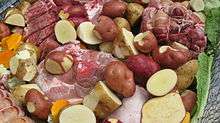Hāngi
Hāngi (Māori pronunciation: [ˈhaːŋi]) is a traditional New Zealand Māori method of cooking food using heated rocks buried in a pit oven, called an umu.[1] It is still used for large groups on special occasions.[2]



Basic process
To "lay a hāngi" or "put down a hāngi" involves digging a pit in the ground, heating stones in the pit with a large fire, placing baskets of food on top of the stones, and covering everything with earth for several hours before uncovering (or lifting) the hāngi.[3]

Prior to colonisation and the introduction of metals and wire, food was laid between bark, large leaves and other vegetation. Wire baskets became widely used in the early 19th century, with sacking and cloth replacing leaves and bark as the covering of choice,[4] and scrap iron or steel may now be used in addition to or instead of stones.[3] There are many variations and details that can be altered. Hāngi "experts" have developed and improved methods that have often, like the stones themselves, been handed down for generations.
In the early 21st century, gas heated stainless steel "hāngi machines" are sometimes used to replicate the style of cooking without the need for a wood fire, rocks and a pit.[5]
Early umu-ti
Evidence from early Polynesian settler sites in New Zealand such as Wairau Bar and in coastal Otago Peninsula from about 1280 shows a significant number of large cooking pits or umu which were designed to cook ti-pore or various other species of Cordyline.[4] The distinguishing feature of an umu-ti was its large size compared to a normal cooking earth oven. This was a common east Polynesian practice in the Cook Islands and Society Islands,[6] and the remains of large umu have also been found in the Kermadec Islands.
The long, carrot-shaped tap root was cooked in a large stone lined pit for between 1 and 2 days. The result was a fibrous mass of sweet pulp with a bitter aftertaste. Investigation in Otago shows that most pits were used only once or twice.
See also
- Clam bake
- Curanto
- Kalua
- Lovo
- Pachamanca
- Rosvopaisti
References
- "umu". Maori Dictionary. Te Aka Online Māori Dictionary. Retrieved 9 November 2018.
- Satyanand, Anand. "Hangi for Prince William". The Governor-General. Retrieved 9 November 2018.
- "He whakatairanga i ngā ahuatanga mahi mō te tunu hāngi: Food safety practices in preparing and cooking a hāngi". New Zealand Food Safety. Retrieved 9 November 2018.
- "The New Zealand Maori Hangi: Foods, Preparations and Methods Used". Genuine Maori Cuisine. Epuro Hands International Limited. 2005. Retrieved October 2, 2012.
- "About the MultiKai Cooker". Multi KC Ltd. 2011. Retrieved October 2, 2012.
- Knight, Hardwicke (1966). "Umu-ti". The Journal of the Polynesian Society. 75 (3): 332–347. Retrieved 9 November 2018.